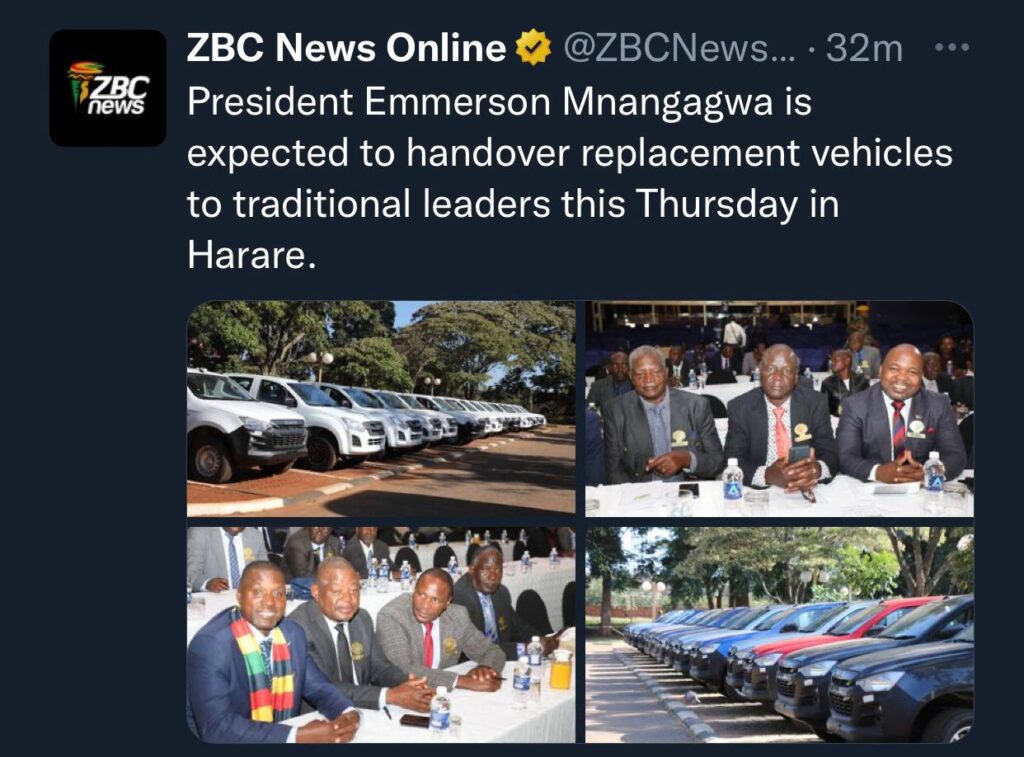A Chief’s Ride or a Mother’s Life: A Matter of Priorities in Zimbabwe
Thabiso Sibanda

On February 29th, 2024, President Mnangagwa ignited controversy by handing out 100 vehicles to chiefs, touting it as a way to restore their dignity. Speaking during the handover the president highlighted that the initiative was part of the government’s ongoing program to support traditional leaders by providing vehicles to ensure their mobility and restore their dignity. “Given the role of our traditional leaders as custodians of our culture, traditions, history and heritage, among other responsibilities, it is necessary that their dignity and conditions be of acceptable standards,” he said. Critics, however, slammed the decision as extravagant, arguing the resources could have addressed the critical shortage of ambulances. Zimbabwe’s maternal mortality rate is alarmingly high, and timely access to healthcare is crucial. This debate highlights the government’s struggle to balance support for traditional authorities with the urgent needs of a nation facing healthcare and economic crises.
The allocation of prestigious vehicles to chiefs during a period of notable economic and social difficulties in Zimbabwe has sparked a contentious debate. Critics, including advocates for democracy, have criticized the decision as extravagant and poorly timed. They contend that the resources expended on this could have been more wisely utilized to tackle the immediate needs of the broader population, like enhancing healthcare services and addressing food insecurity. This discussion underscores the enduring challenge of reconciling the backing of traditional authority figures with the urgent requirements of a nation grappling with various crises. This gesture has been interpreted by some as a reward for political support rather than a genuine effort to enhance traditional governance.
Defenders of the move, like Chief Mtshane, chairman of the national chief’s council, downplayed the controversy, claiming this was a routine practice. Yet, the emphasis on “restoration of dignity” rings hollow when juxtaposed with the plight of pregnant women in rural areas who sometimes resort to ox-drawn carts to reach health facilities. As Fadzai Mahere, a former legislator, pointed out, Masvingo, a city with over 90,000 residents, has only one ambulance, while chiefs receive regular car upgrades.
Zimbabwe has a maternal mortality rate of 363 per 100,000 live births, which is significantly higher than the global target of less than 70 . This means many women die from preventable causes related to pregnancy and childbirth. Notably, one of the major causes of such a high maternal mortality rate as defined by the 3 delays model is the delay in reaching a health facility. This speaks to limited or unreliable public transport, poor road conditions, and lack of readily available ambulances all contribute to this delay.
This misplaced priority has deadly consequences. A 2022 incident where the sole ambulance serving Nkayi district crashed highlights the dangers. It was reported that a wheel had come off in an extremely bad part of the road causing the ambulance to overturn. Patricia Nyoni, 35, was a referral from Mateme Clinic to Nkayi District Hospital after developing complications during childbirth. The accident not only claimed the life of a mother and her unborn child but also left the entire district without emergency transport. Shockingly, Chief Sikhobokhobo of Nkayi dismissed concerns about healthcare challenges in Nkayi , stating, “The country belongs to the chiefs.”
The allocation of luxury vehicles to chiefs while mothers die due to a lack of ambulances is a symptom of misplaced priorities. Zimbabweans deserve better. To safeguard the lives of mothers and newborns, the government must urgently address the critical shortage of ambulances, invest in healthcare infrastructure, and prioritize accessible emergency obstetric care. Only then can women receive timely, life-saving interventions during childbirth.
The choice is clear: a mother’s life or a symbolic gesture!

What’s up to all, the contents existing at this web page are actually awesome for people experience, well,
keep up the good work fellows.
It’s hard to come by educated people for this subject, however, you seem like
you know what you’re talking about! Thanks